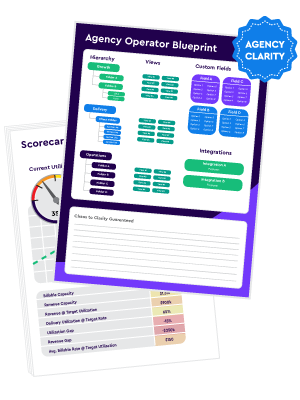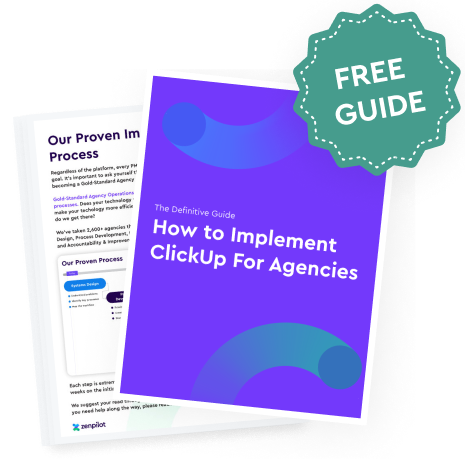What’s the Key to a Good Process Template?
Since we’re already talking tools and technical setup, I wanted to go a level deeper into that.
I asked Maggie to reveal what the secret sauce is for configuring process templates effectively in ClickUp (or any tool). Here’s the insider insight she gave:
“The most critical part is the custom fields you require for each subtask.
For example, when you build your ‘Email Campaign’ template, each subtask should have fields like: Task Type, Work Category, Team, Account Manager, Client, Due Date, Time Estimate.
With this info baked into every subtask, team members get all the context they need to complete each step every day, without having to look elsewhere.”
Free Download: Add Our Client Onboarding Template To Your ClickUp Workspace
The key is having custom fields on subtasks that provide all the necessary context in one place. This is crucial for visibility.
And that leads to an important mindset note...
How High Should You Set the Standard for a Streamlined PM Setup?
The custom subtask fields Maggie mentioned enable you to create a PM setup where team members aren’t left guessing.
I highlighted that as the key standard agencies should aim for. In my own words:
“With the right setup, you can get to a point where when you ask yourself ‘Did I forget anything?’ the answer is always ‘No.’ All tasks and context are documented.
It takes work to get there. But that's the vision you should strive for – having the peace of mind that it's all in the system.”
Of course, this level of streamlining doesn't happen overnight. It requires evolving workflows, processes, and team habits.
Read: The Best ClickUp Hierarchy For Agencies
Which leads me to the next question for Maggie...
How Does Changing Team Habits Unfold During Implementation?
Earlier Maggie touched on why changing team habits is such a hurdle. I wanted to go deeper into what the process of overcoming that actually looks like.
Here’s what she outlined:
“You have to position this PM overhaul as a benefit to end users by showing how it will reduce their stress and make their jobs easier.
For example, you could explain it this way:
'We know at the end of each day, you feel stressed when things go wrong. The changes we'll make are going to prevent that stress by improving workflows.' Being able to show them that light at the end of the stressful tunnel will encourage buy-in.
But you can’t just talk at team members. You have to listen and provide solutions. Ask them how they want their ideal weekly workflow to look. Use that to configure the PM tool to solve their pains.”
Notice the emphasis on listening, empathizing, and positioning it as a benefit to users. The key is realizing this is essentially an internal marketing project.
To make change work, you have to appeal to team members and show “what’s in it for them.”
Now I’ll switch gears to some tactical insights from Maggie’s experience...
How Much Can You Standardize Implementations?
One of the things that originally intrigued me about ZenPilot was that the role was called “Client Coach.” That was new to me.
I assumed that meant some sort of standardized coaching process.
So I asked Maggie how much they’re actually able to standardize across different agencies:
“We’ve tried to standardize as much as possible, with set agendas for each week. But in reality, there is so much customization for each client, it’s impossible to have a cookie cutter approach.
Almost every week, something new comes up with a client that demands a unique solution. It all depends on how that agency works specifically and the problems they face.”
The takeaway - while structure and best practices are important, you also need to remain flexible. Each agency has a unique culture and ways of working. Target your solutions specifically to them.
Now, let’s get into a real-world example...
What’s an Example of a Complex Custom Solution You Created?
Since every agency is so different, I asked Maggie to share a story about a time they had to get creative in solving a complex or unusual problem.
She told me about one of their clients based in NYC that did huge photo and video campaigns for luxury brands. Here’s how she described the custom solution:
“We created a studio and talent manager inside their ClickUp. Every piece of a photo shoot was tracked - models, photographers, editors, videographers, caterers, locations. All the human elements.
There was a massive integration of financial and scheduling information to match models, studio availability, budgets. It was incredibly complex, but also highly usable.
The key was having their main point person completely bought in. She invested her own time to learn it deeply. Now it’s one of our crowning template achievements.”
The story highlights a few key points:
- With the right partnership, you can create highly custom solutions in ClickUp suited to your exact business needs.
- But complexity requires simplicity on the user end. That comes down to clean design.
- Another essential ingredient is having a champion on the agency side who’s dedicated to learning and adopting the new solution.
The more complex the problem, the more critical buy-in becomes.
Turn Chaos Into Clarity.
We're your agency operations pilot.
You can build a happier, more productive, more profitable team with ClickUp. We'll show you how.
I decided to probe deeper into something that caught my attention here.
How Do You Go Beyond Tasks to Manage Talent and People in ClickUp?
I asked Maggie to answer a common ClickUp misconception that goes something like this:
“But wait, you're talking about managing models and studios - I thought ClickUp was just for tasks?”
Maggie had the perfect response:
“With the ZenPilot framework applied to ClickUp, you can solve almost any problem agencies face - whether a tax firm, library, or a NYC photo studio.
Yes, the base unit in ClickUp is a task. But there’s so much more you can do with the right setup. I've yet to come across any business you can't run in ClickUp. It's incredibly flexible despite being a task management platform on the surface.”
So don’t think you’re limited to basic task management. As Maggie said, she has yet to see a business that can’t be run on ClickUp once configured correctly.
Benchmark Your Agency Ops
Take the Agency Project Management Benchmark Assessment to see how your operations stack up against 3,000+ other agencies.
Key Takeaways for Streamlining Your Agency
Before wrapping up this post, I want to highlight a few key takeaways from my conversation with Maggie:
First - Think beyond surface-level when assessing your agency's PM problems. There may be underlying process and workflow issues that require "rewiring" your operations.
Second - Changing team habits and mindsets is crucial. Workflows don't run themselves. Position any PM overhaul as a direct benefit to employees by making their work lives easier.
Third - Customization will be key. There's no one-size-fits-all solution. Keep adapting to your agency's needs, evolving as you go.
Fourth - Make sure you have dedicated champions who take ownership of learning and adopting new solutions. Especially for complex workflows.
Fifth - Set the standard of "everything being in the system" as your North Star. It takes work to get there, but that should be your goal.
And finally - ClickUp is incredibly flexible if set up properly. Let your workflows and needs dictate the solution - not the other way around.
Hopefully this gives you fresh perspective.
Want to take the next step?
We've helped 2,700+ agencies streamline their operations in ClickUp and improve their workflows, processes, and culture.
Get a free consultation with ZenPilot here to start diagnosing your PM and workflow challenges.
The Only Fully Guaranteed Agency Operations Improvement Framework
Get 360 clarity into your operations or your money back, guaranteed.








